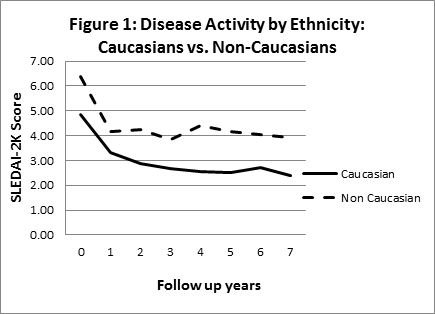Session Information
Date: Tuesday, November 10, 2015
Title: Systemic Lupus Erythematosus - Clinical Aspects and Treatment Poster Session III
Session Type: ACR Poster Session C
Session Time: 9:00AM-11:00AM
Background/Purpose: The evolution on an annual basis of
disease activity and damage and the annual accrual of ACR criteria and key
autoantibodies in patients with SLE is not well described. We report the
annual occurrence of these features in an inception cohort of patients with
SLE.
Methods: An
international research network comprising 33 centres from 11 countries has
followed an inception cohort of SLE
patients yearly according to a standardized protocol between 2000 and 2014. Of
these, 748 patients followed for a minimum of 7 years constitute the study
population. Clinical disease activity was assessed using SLEDAI-2K and disease
damage using the SLICC/ACR Damage Index (SLICC/DI). ANA, Anti-DNA and anticardiolipin,
antibody levels, the presence of the lupus anticoagulant were assessed at each
visit. Descriptive statistics were used.
Results: Of the 748 patients followed for at least 7 years, 90.2%
were female, 49.1% were Caucasian, 14.8% were Black, 16.3% were Asian, 15.9%
Hispanic and 3.9% other. 40.8% were married and 57.2% had at least College
education. Their mean age at enrolment was 34.7±13.4years and SLEDAI-2K at
enrolment was 5.6±5.7. The duration from diagnosis to enrolment was 5.5±4.2
months.
|
Table 1: Mean SLEDAI-2K, SDI and ACR Accumulation in the First 7 Years of Follow-up |
||||||
|
FU |
Annual SLEDAI-2K |
SDI |
Cumulative ACR Criteria |
|||
|
|
N |
Mean ± std |
N |
Mean ± std |
N |
Mean ± std |
|
0 |
745 |
5.62±5.70 |
632* |
0.14±0.49 |
748 |
5.05±1.13 |
|
1 |
679 |
3.75±4.33 |
678 |
0.44±0.88 |
679 |
5.42±1.25 |
|
2 |
660 |
3.57±4.32 |
660 |
0.55±1.01 |
660 |
5.65±1.34 |
|
3 |
636 |
3.28±3.56 |
637 |
0.68±1.12 |
637 |
5.84±1.39 |
|
4 |
605 |
3.50±3.95 |
625 |
0.80±1.22 |
625 |
5.93±1.37 |
|
5 |
619 |
3.35±3.94 |
621 |
0.92±1.35 |
621 |
6.04±1.42 |
|
6 |
619 |
3.39±3.95 |
621 |
1.00±1.42 |
621 |
6.14±1.46 |
|
7 |
620 |
3.17±3.57 |
624 |
1.08±1.45 |
624 |
6.16±1.43 |
*SDI
performed only in those patients with > 6 months disease duration
|
Table 2: Auto-Antibodies and Lupus Anticoagulant Over 7 Years |
||||||||
|
|
Anti-Nuclear Antibody |
Anti-DNA |
Anticardiolipin |
Lupus Anticoagulant |
||||
|
FU |
N |
% |
N |
% |
N |
% |
N |
% |
|
0 |
748 |
96.2 |
637 |
41.2 |
584 |
14.7 |
618 |
21.8 |
|
1 |
679 |
97.4 |
624 |
31.7 |
498 |
12.0 |
499 |
19.7 |
|
2 |
660 |
97.4 |
649 |
30.9 |
440 |
11.9 |
440 |
20.9 |
|
3 |
637 |
97.4 |
633 |
28.5 |
375 |
9.5 |
377 |
24.2 |
|
4 |
625 |
97.5 |
620 |
31.6 |
263 |
11.7 |
266 |
20.3 |
|
5 |
621 |
98.1 |
615 |
33.3 |
195 |
8.0 |
201 |
23.2 |
|
6 |
621 |
98.0 |
612 |
35.5 |
178 |
8.6 |
174 |
15.9 |
|
7 |
624 |
98.1 |
606 |
34.5 |
119 |
9.6 |
115 |
11.6 |
Mean SLEDAI-2K decreases to low levels in the first
year and then remains low. SLEDAI-2K was significantly lower at each year in
Caucasians compared to Non-Caucasians. Mean SLICC/DI increases progressively
over the 7 years but there was no significant difference at each year between
Caucasians and Non-Caucasians. Mean ACR criteria accumulation gradually
increases over 7 years, with Caucasians accumulating less ACR criteria in the
first 2 years of disease as compared to Non-Caucasians.
Although ANA positivity is high at enrolment, the
percent positivity remains stable over 7 years. Frequency of anti-DNA
positivity is high at enrolment and decreased by almost 7% over 7 years.
Anticardiolipin antibody and the lupus anticoagulant decreases by 5% and 10%
over 7 years respectively.
Conclusion: As expected disease activity in newly diagnosed patient’s
decreases over their first 7 years but disease damage increases. Similarly,
key antibody levels with the exception of ANA positivity decreased over the
first 7 years of disease.
To cite this abstract in AMA style:
Urowitz M, Gladman D, Anderson N, Su J. Evolution of Disease Burden over 7 Years in a Multicentre Inception SLE Cohort [abstract]. Arthritis Rheumatol. 2015; 67 (suppl 10). https://acrabstracts.org/abstract/evolution-of-disease-burden-over-7-years-in-a-multicentre-inception-sle-cohort/. Accessed .« Back to 2015 ACR/ARHP Annual Meeting
ACR Meeting Abstracts - https://acrabstracts.org/abstract/evolution-of-disease-burden-over-7-years-in-a-multicentre-inception-sle-cohort/

